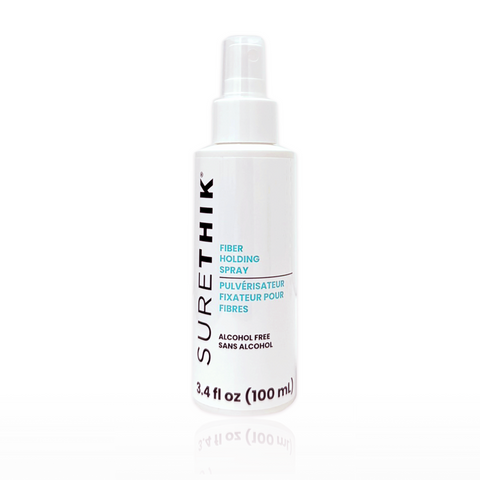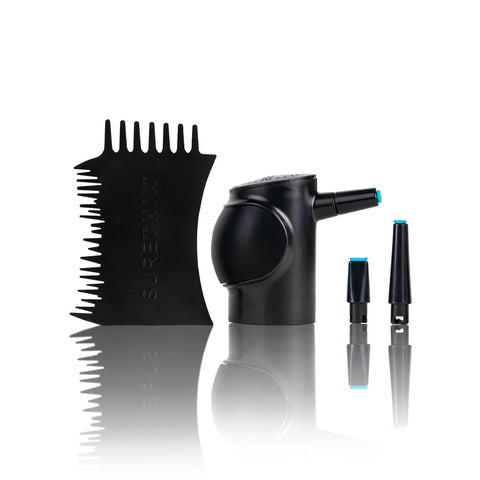
Are Hair Building Fibers Effective?
Hair fibers are said to be a potential solution to hair thinning, but are they really effective? To answer this question, it is important to understand your need and what your intention are when using hair fibers.
Hair fibers are a great solution if you're interested in a quick, easy way to make thin spots on your hair appear thicker. This is similar to how makeup conceals acne, lines, and blemishes without treating them. Since fibers bond to your natural hair, they can be easily applied to thinning areas and your scalp where baldness occurs. Using colored hair fibers can also hide gray roots that develop over time if your hair is dyed. However, it can in no way help reverse hair loss. It’s a temporary solution to thicken your hair, just as makeup is to smooth the appearance of your skin!
Here are some tips to understand how to use hair fibers and maximize their effectiveness. Let’s start by exploring what hair fibers really are.
What is Hair Building Fiber?
Hair Fibers, also known as hair building fibers or hair thickening fibers are available in two forms, spray on and shake on powder. By adhering to real hair, these fibers thicken and volumize your strands, hiding the signs of thinning. The static electricity in volumizing hair fibers enables them to adhere to hair strands and blend with your hair. The application of these products is undetectable when done correctly.
Some fibers are made of 100% keratin, which is naturally found in human hair, and come in an array of colors to seamlessly match your shade. The highly effective and fast-acting keratin fibers were originally developed to hide thinning hair in men and women but have quickly become a favorite among style influencers and fashionistas. Others are made from synthetic materials which reduces their cost however, these tend to be clumpy and far less natural looking.
10 Tips To Use Hair Fibers
- It’s important to choose a shade that matches your natural hair color. For colored hair, choose the fibers in the shade of your hair color. This will make the appearance of hair fibers natural when applied. We recommend matching your exact hair shade, or a shade that is slightly darker than your natural hair color. Make sure to match the fibers to your base or root color. If you are in between shades, go with the darker one. You can also mix colors to make a custom shade. It is ideal for beginners, to go for a brand that has a good variety of colors and great reviews.

- The hair-building fibers cannot bind to wet hair, so use them on dry hair. The hair becomes clumped when wet, preventing even distribution. If you want to avoid washing the product off your scalp, avoid swimming with it on.
- Avoid overusing hair fibers. Start by applying a small amount and build up gradually until you reach your desired coverage.
- Avoid combing after the application of hair fibers, because that will remove the product from the hair. It is best to style your hair before applying the product. A common mistake is using too much product which ends up looking unnatural.
- For a longer-lasting hold, use a fiber-holding spray. The fibers are electro-statically charged so they stick to the hair and scalp naturally. However, using a fiber-holding spray increases the bond between the fibers and your natural hair, thereby reducing the chance of the fibers becoming displaced. We recommend using a fiber-holding spray that is alcohol-free so that it does not damage your hair in the long term.
Here are some of our favorite holding sprays:

- After applying topical hair fibers, avoid using heat-styling tools. Style your hair first and then apply the fibers.
- For precise application, use a hair fiber applicator. In this way, the hair fibers are spread evenly, giving a more natural appearance. We recommend investing in a high-quality patented applicator that gives even distribution of fibers. The last thing you want is to use an applicator that produces blotchy results on your scalp.
- Hair fibers should not be applied to oily or deeply conditioned scalp. Oils and conditioners minimize the negative charge on the hair. This prevents hair fibers from adhering to the strands properly.
- To fill in your hairline with hair fibers, use a hair fiber comb. This will help in precise application and help achieve a natural-looking hairline.
- We do not recommend using a hair mousse, smoothing serum, or hair cream before applying the hair fibers. By reducing inter fiber friction, smoothing products make it challenging for fibers to attach to hair shafts naturally. Instead, we recommend using a thickening shampoo that adds volume to your hair. This will reduce the need for a mousse or hair cream and will make your hair look thicker.
Here are some of our favorite thickening shampoos:
Final Verdict
To answer the question, do hair fibers really work? We would say absolutely! The purpose of hair-building fibers is to increase hair density in areas with limited hair mass. If your hair is thinning, keratin fibers are your secret weapon, and you don't need to spend a lot on them. Additionally, premium-quality hair fibers are completely safe for everyday use. When applied to your thinning hair, the hair fibers cling to the individual strands, without clogging the dermal layer of the skin on your scalp. Provided that your hair is in a healthy condition, premium-grade hair thickening fibers will not harm your hair and skin.
Here is our top pick:







